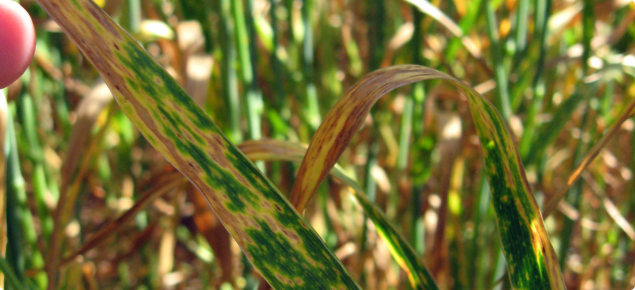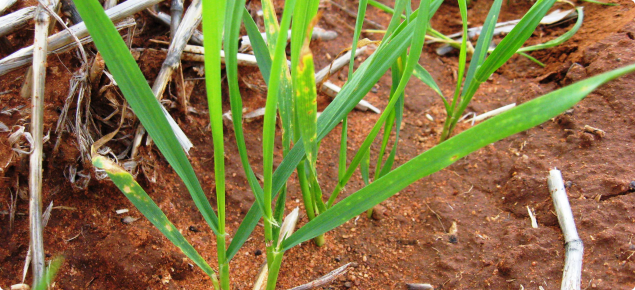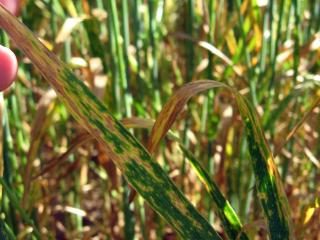Leaf spot diseases affecting wheat in WA are yellow spot (Pyrenophora tritici-repentis), septoria nodorum blotch (Parastagonospora nodorum; previously Phaeosphaeria nodorum, synonyms Stagonospora nodorum, Septoria nodorum), and septoria tritici blotch (Mycosphaerella graminicola). They are caused by three different fungal pathogens but the disease symptoms and biologies are similar.
Symptoms
Leaf spot diseases in wheat appear as irregular or oval-shaped spots that initially are small and often yellow (sometimes blackish-brown), but enlarge to form brown dead centres, with yellow edges. Typically, a badly affected leaf will die back from the tip as lesions merge, reducing the photosynthetic area and causing premature leaf death. Differentiation of septoria nodorum blotch, septoria tritici blotch, and yellow spot on the basis of symptoms is difficult even to a trained eye. Some physiological or nutritional yellowing symptoms can be confused with yellow spot and septoria so it is important to get a correct diagnosis. More details on symptoms of each are available on the MyCrop pages at yellow spot, septoria nodorum blotch and septoria tritici blotch. See 'Disease diagnosis' section for diagnosis assistance that is available through DDLS - Plant pathology services.
Prevalence and yield loss
Septoria nodorum blotch and yellow spot may occur throughout the wheatbelt and frequently occur together. They have the capacity to significantly reduce yield and grain quality. Septoria tritici blotch has become less common throughout the WA wheatbelt and currently losses from this disease are rare. As such the remainder of this information here refers to yellow spot and septoria nodorum blotch.
Impacts from yellow spot and septoria nodorum blotch vary greatly from season to season and between locations. They are particularly a problem in continuous wheat crops in stubble retention farming systems. Yield loss will depend on the disease resistance of the variety and the presence and severity of the disease throughout the life of the crop. For susceptible varieties, when the disease development is continuous due to favourable conditions throughout the season, losses around 30% have been measured. When disease development is only favourable for part of the season, either before or after flag leaf emergence, losses around 20% can occur. Severe disease will cause grain quality reductions such as increased screenings and lower hectolitre weights that can add to high yield loss impacts.
How disease spreads and the risk factors
Primary infection of leaf spot diseases is from infected wheat stubble. The fungi that cause leaf spot diseases survive from one season to the next as fruiting bodies on wheat stubble (pseudothecia or pycnidia) or as mycelium in living, volunteer plants. Yellow spot pseudothecia on wheat stubble appear as black raised specks and feel like braille dots when rubbed between the thumb and index finger.
With the onset of winter rains, the over-summering fruiting bodies on stubble release ascospores. Ascospores of septoria nodorum blotch and septoria tritici blotch are readily airborne and result in wide dispersal (over kilometres) while those of yellow spot are larger in size and are dispersed over shorter distances (over metres). Once wheat plants are infected, secondary disease spread occurs — conidia are produced from the leaf infections and these spores are then water dispersed or wind blown through the crop canopy. During the growing season, several cycles of both primary and secondary infection can occur.
DPIRD (Department of Primary Industries and Regional Development) research has found that the timing of yellow spot spore maturation on stubble differs at different locations in the wheat belt. The release of spores from the fruiting bodies on the stubble is dependent on temperature and rainfall conditions. The wetter, cooler conditions on the south coast for example (around Albany) favour the release of spores before wheat crops are sown or have emerged. On the other hand, the temperature and moisture conditions at Northam and Eradu favour ascospore development from May through to September which coincides with the crop growing season. This provides some explanation why yellow spot is usually more prevalent in the northern agricultural regions compared with the southern agricultural regions. For further reading on this subject see 'Research and further information' at the end of this page.
Double wheat cropping
As they are stubble-borne, these diseases (but particularly yellow spot) will be most serious in continuous wheat cropping under stubble retention systems. Varieties rated as susceptible to these diseases are particularly vulnerable to infection when sown on wheat stubble and in the absence of fungicide they can sustain significant yield losses.
The fungi that cause these diseases survive on wheat stubble very well for six months between continuous wheat crops but relatively poorly after 18 months, such as wheat grown in one-year rotation with other crops or pasture. Use crop rotation to reduce risk from these stubble-borne diseases.
Weather
While rotation and variety will influence individual crop risk, risk of disease outbreaks that will significantly reduce yield is influenced by rainfall (in autumn, winter and spring). The causal pathogens of the various leaf spot diseases have different environmental conditions that are conducive to disease spread.
For yellow spot, primary infection of wheat leaves (from stubble) requires at least six hours of leaf wetness with temperatures of 15-28°C and periods of dew. Secondary infection (leaf to leaf) is favoured by leaf wetness (dew, fog or rain), high relative humidity and temperatures above10°C.
Septoria nodorum blotch development is favoured by warm weather (such as 20-25°C) in association with heavy and frequent rain; infection depends on leaves remaining wet for more than six hours.
Analysis of rainfall information collected at experimental sites between 1997-2004 has demonstrated that an economic response to fungicide (in terms of disease impacts) is more likely when the crop receives approximately 100mm rainfall or more in the eight weeks following flag leaf emergence. The likelihood of meeting this criterion is increased for:
- early sown crops, as canopy development is complete by late winter (early flag leaf emergence exposes leaf to more disease)
- high rainfall areas or years of above average seasonal rainfall.
Nutritional deficiencies
Research by the DPIRD has shown that wheat crops that are deficient in nitrogen and/or potassium are more vulnerable to infection by these diseases. Crop update papers are available on these research results by seeing 'Research and further information' at the end of this page.
Management strategies
For the most effective control, an integrated disease management approach is required.
-
Use crop rotation to reduce risk from these stubble-borne diseases.
- Avoid very susceptible or susceptible varieties. Favour moderately resistant-moderately susceptible varieties. See the latest wheat variety information for disease ratings.
- Ensure crop has adequate nutrition (particularly nitrogen and potassium).
Fungicides
- No seed treatments or in-furrow fungicides are registered for control of septoria nodorum blotch but one seed dressing is registered for suppression of early yellow spot in wheat - the active ingredients are azoxystrobin/metalaxyl-M active (eg Uniform) and field trials have confirmed its effectiveness. Some seed treatments can partially control septoria tritici blotch but are generally not used in this context in WA as it is a minor disease in WA and rarely causes yield loss. Registered seed treatments for septoria tritici blotch, including some flutriafol and triadimenol seed dressings, any fluquinconazole seed dressings and flutriafol in-furrow/onfertiliser treatments. Of the currently registered seed dressings and in-furrow fungicides, none are registered for control of the much more common disease septoria nodorum blotch as none have demonstrated control of this disease. For more information see the Registered seed dressing and in-furrow fungicides page.
For wheat grown in rotation, foliar fungicide is more likely to be economic when applied:
- at or around flag leaf emergence (Z39)
- in crops having good yield potential
- where there is evidence of increasing leaf spot intensity down the canopy
- when there are good prospects of finishing rains (approximately 100mm in the two months after flag leaf emergence).
For wheat after wheat:
- when there is high disease pressure prior to stem elongation, it may be economic to apply fungicide at or prior to early stem elongation (Z31, first node) particularly in medium to high rainfall areas. A second spray may be required at or after flag leaf emergence based on the above considerations.
General fungicide recommendations
- Presence of other foliar diseases will enhance returns from fungicide application and direct fungicide choice. Strategies for control of rust diseases with fungicide can vary in important aspects of timing of application.
- Use higher rates of fungicide for longer duration of protection, for example, when seasonal conditions favouring infection are likely to persist, for highly susceptible varieties or in long season environments.
- Rate and therefore cost should be tuned to crop yield potential; Use a high rate (125g of ai/ha) for crops with high yield potential. Refer to product labels.
- Late onset of disease (particularly with septoria nodorum blotch - see glume blotch below), may warrant a spray prior to flowering (for example, 50% heads emerged: Z55), particularly in long season environments.
- Late spraying is sub-optimal and spraying after crop flowering finishes is generally not economic but further research is being done on this.
- Information on which foliar fungicides are registered for leaf spot diseases is available on the Registered foliar fungicides for cereals in WA page.
YellowSpotWM
YellowSpotWM is a decision support tool that assists growers and consultants in determining the best management strategy to reduce yellow leaf spot disease in wheat and increase profits. The user can specify factors relating to paddock selection, variety, seasonal conditions, prices and management options so that the output relates to their cropping circumstance. It is free and works on iPad or android tablets or phones so can be used in the paddock to determine the likely economic returns from a spray decision. Further information is available on the YellowSpotWM decision suppot tool page including links to download the tool.
In the webinar below, Geoff Thomas and Anna Hepworth (DPIRD) discuss Yellow leaf spot disease in wheat and share some tips for using the YellowSpotWM decision support tool when making fungicide spraying decisions.
Glume blotch
Septoria nodorum blotch, when severe late in the season, can attack wheat heads during grain-fill causing dark patches on the glumes. This is known as glume blotch. Care needs to be taken to distinguish it from other causes of darkening on the glumes which include pseudo black chaff, loose smut, frost and copper deficiency. DDLS - Plant pathology services can provide assistance with diagnosis.
Head infection can lead to the production of shrivelled grain so screenings will be expected to increase with severe infections. It is important to optimise control of septoria (stagonospora nodorum) on leaves to reduce risk of infection of heads. This can be best achieved by applying fungicide before or during crop heading.
Disease diagnosis
It should be noted that a variety of factors can cause spotting on wheat leaves and the cause is not always a fungal pathogen. For confirmation on disease diagnosis, send 25 infected stems to DDLS - Plant pathology services, Department of Agriculture and Food, Western Australia, Locked Bag 4, Bentley Delivery Centre WA 6983 or call +61 (0)8 9368 3721. This is a chargeable service.
Reporting disease
Please report disease finds to PestFax for the benefit of other growers and the WA wheat industry. You can report disease finds directly online at the PestFax map or otherwise contact the PestFax editor via the PestFax page. PestFax is a free weekly newsletter during the growing season providing information on broadacre disease and pest reports in the WA grainbelt.
Research and further information
DPIRD has been conducting research into managing yellow spot and septoria nodorum blotch in wheat for decades and research is still ongoing. Research has expanded our understanding of how the diseases spread, why the diseases are more prevalent in some regions or seasons than others, factors involved in carryover of stubble-borne inoculum and the importance of crop rotation, and development of effective fungicide strategies. Research into developing new varieties that have increased resistance to yellow spot continues, field trials looking at fungicide spray timing in a range of rainfall environments and investigations into how environment affects spore release from stubble are ongoing. Our key research results are available in Crop Updates papers and journal articles, some of which are available via the links on the right and/or listed below.
- DPIRD has been working on a long running pre-breeding research collaboration, funded by GRDC, which has identified a total of 19 genes with varying amounts of resistance to yellow spot. The discovery of new resistance genes gives wheat breeders additional material from which to develop varieties with higher and more durable levels of resistance to yellow spot.
- Less yellow spot in wheat - progress towards a decision support tool, 2016 GRDC Grains Research Updates, Jean Galloway, Moin Salam and Pip Payne. Available on the 2016 GRDC Grains Research Updates GIWA page.
- Stacking yellow spot resistance genes into fixed lines results in genetic gain, 2015 Crop Uppates, Manisha Shankar et al. Available on the 2015 Crop Updates GIWA page.
- Potassium deficiency can make wheat more vulnerable to septoria nodorum blotch and yellow spot, 2014 Crop Updates, Ciara Beard and Anne Smith. Available from the 2014 Crop Updates GIWA page under 'Papers submitted (not presented).'
- A meta-analysis of 30 years of DAFWA field trials on fungicide management of yellow spot - septoria nodorum blotch disease complex of wheat in Western Australia, 2013 Crop Updates, Kawsar Salam et al. Available from the 2013 Crop Updates GIWA page under 'Session 18.'
- Environment affects maturation of yellow spot on wheat stubble, 2013 Crop Updates, Jean Galloway et al. Available from the 2013 Crop Updates GIWA page under 'Papers submitted (not presented).'
- Interaction of Nitrogen and Fungicide applications for Managing Yellow Spot in Wheat, 2012 Crop Updates, Ciara Beard and Anne Smith. Available from the 2012 Crop Updates GIWA page or from Ciara Beard upon request.
- Early fungicide application can be profitable for Managing Yellow spot and Stagonospora Nodorum in Wheat-on-Wheat cropping, 2012 Crop Updates, Ciara Beard and Anne Smith. Available from the 2012 Crop Updates GIWA page or from Ciara Beard upon request.



